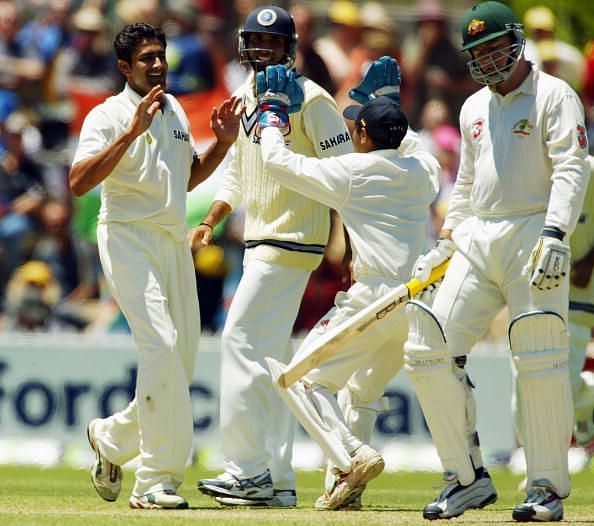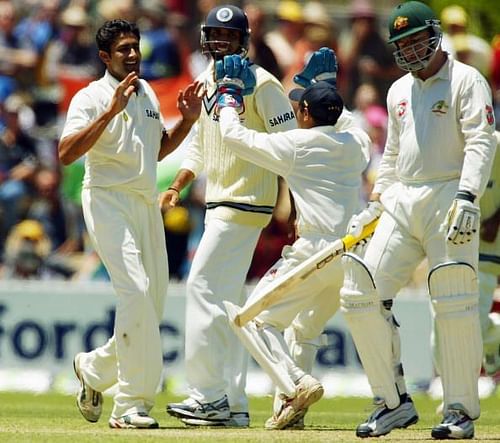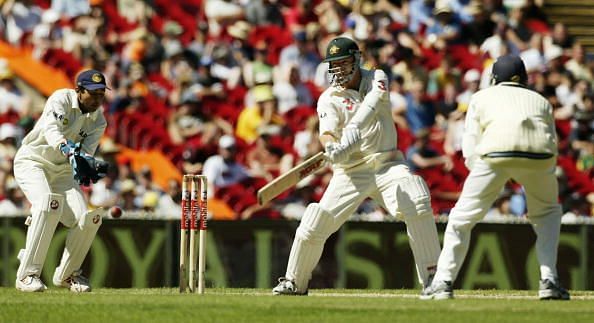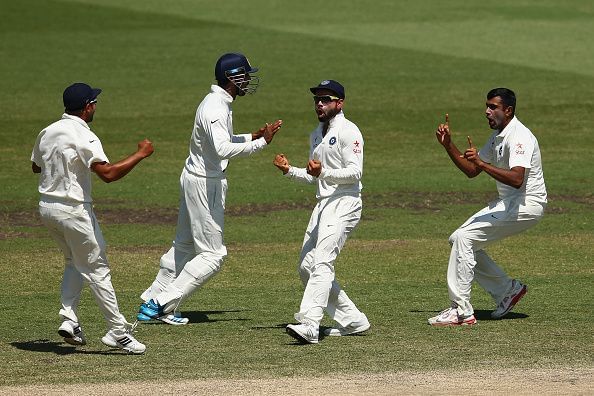
How India almost won the 2003-04 series in Australia when Anil Kumble peaked

It was towards the end of November 2003, when the Indian team was embarking on what was to be a historic tour of Australia. The team's performance for a full year till that point had been heartbreaking, to say the least. After a dream run in 2002 that included their first ODI series win in the Caribbean, the Natwest Series title, a rare overseas innings victory in Headingley and a shared ICC Champions Trophy, things did not quite go in the team's favour after West Indies finished the Test leg on their tour to India.
India lost a home ODI series against the West Indies, and the Test as well as the ODI series in New Zealand by humiliating margins. After losing their second match in the 2003 World Cup to defending champions Australia, the team enjoyed a dream run in the tournament right up till the final, where Australia again shattered India's dreams completely surpassing India in all three departments of the game.
India had to share the TVS Cup in Bangladesh with South Africa as the final was rained out, they could not manage a single win in the home Test series against New Zealand and yet again lost a final to Australia - during the year-end TVS Cup at home.
All in all, India looked like scaling unprecedented heights throughout that year but did not win a single Test or ODI series for more than a year when they were on the flight to Australia. Though the team had just started winning Test matches abroad, their record against Australia in Australia was forgettable.
Though Bishan Singh Bedi's men came quite close to substantiating the most impossible of turnarounds on their Australian tour in 1977-78 after coming behind from 0-2 to within touching distance in a five-match series, the team would rarely give Australia a fight in their own backyard in the years to come.
India registered their only other Test match victory in Australia in the third and final match of the 1980-81 series, which helped them draw the series. The team did not win a single Test series outside Asia during the '90s and while they came quite close on occasions after Sourav Ganguly's appointment as Test captain, this time they were up against the most dominant team of that era.
Anil Kumble was not supposed to be part of that squad, as Ganguly himself confessed during a motivational speech just about a year ago. India's highest wicket-taker was being looked down upon as a liability by the selectors, and his average record in overseas Tests till that point did not help his case one bit. The captain, however, was hell-bent on taking his senior pro and forced the selectors to take him to Australia, risking his own position as a captain had Kumble failed.

We are not sure if Kumble knew about this, but he surely knew his position in the team was under threat, with the emergence of Harbhajan Singh, Murali Kartik and other spinners on the scene. Kumble did not participate in the warm-up match at MCG or the drawn first Test in Brisbane. A finger injury to Harbhajan ruled him out for the remainder of the tour, and Murali Kartik was flown in as cover. Kumble made a comeback in the second Test at Adelaide.
Australia decided to bat first on a hard and flat wicket, and while Matthew Hayden returned fairly quickly, there was nothing holding back Justin Langer and Ricky Ponting. After an attacking hundred-run partnership, Kumble was finally rewarded when he got the wicket of Langer. Ponting, however, continued to attack and build helpful partnerships with all the middle order batsmen.
By the time Australia's last recognized batsman Adam Gilchrist got out, Australia looked in a commanding position, and Ponting found able support from Andy Bichel. The two took the team score to 473 for six. Kumble's experience came to the fore and he got not only the wickets of Bichel and then Ponting, but also those of the last two batsmen - taking the last three wickets for zero runs. This was Kumble's first five-wicket haul outside India after six years.
Australia's first innings score of 556 looked daunting, especially after India were 85 for 4 in their first innings. However, Rahul Dravid and VVS Laxman had other plans and their partnership looked as good as their Kolkata feat in 2001, if not better. The absence of Warne and McGrath was apparent, but the kind of form that Indian batting pair was in, they would have given Australia's best bowling pair a run for their money.
Eventually, India did not concede a big first innings lead, and Agarkar's six-wicket haul in the second innings meant that India were chasing a manageable target. India lost the third Test at Melbourne in a similar way they won the second Test. While India came back from behind in Adelaide, this time the home team made a comeback after a stunning start to India's batting. The final Test - which was also going to be Australia's legendary batsman Steve Waugh's finale - looked nothing less than a cricketing epic.
While India's big five - Sehwag, Laxman, Ganguly, Dravid and Sachin - all found their moments of glory in the series; the find of the series was their bowling veteran, Anil Kumble. Kumble took 24 wickets in a series in which the next best bowler took 16. That after playing one match less than most other bowlers. 24 wickets, even in a five-match series in favourable home conditions is appreciated even today.
But if those wickets come against the best batting lineup of the twenty-first century - Matthew Hayden, Justin Langer, Ricky Ponting, Damien Martyn, Steve Waugh, Simon Katich, Adam Gilchrist and capable lower order batsmen such as Gillespie, Lee and Bichel - in their own den, that speaks volumes about the bowler. He took one five-wicket-in-an-innings in each of the three Test matches, which is still rare for any bowler playing away from home.
Kumble's bowling average in that series was 29.58 in a series where the second-best bowling average was above 37. For a bowler who suffered outside home for the first half of his career, Kumble finished with over 140 wickets playing only in Australia, England, South Africa and New Zealand - with 49 wickets from just 10 Tests in Australia. Kumble still has the most wickets for any players with 20 or fewer Tests against Australia - the most dominant team in the time he played.
Kumble's amazing 12-wicket haul in the Sydney Test match almost brought Australia to their knees, even as a defiant Steve Waugh managed to keep the series victory from India with the help of Simon Katich - who carried his bat in the end. Kumble bowled half the overs in a long and hard-fought day of Test match cricket and was only looking for wickets in an attempt to secure India their rarest and biggest series victory. His career was revived and he took over 80 wickets that year, followed by another 200 in the next four years.

The point to note here is that for India to win or even come close to winning a Test series in Australia, one of the spinners will have to put his hands up. A spinner yes, because wickets in Australia would be harder and less green than those in England, and only spinners can bowl marathon spells in relatively hot conditions like those in Australia. Ashwin - a certainty for tomorrow's match - has toured Australia twice previously and in his stellar career, he has managed only 40 wickets in Australia, South Africa, England and New Zealand so far.
Ashwin has 21 wickets in 6 Test matches at an average above 54 in Australia so far, and looked far from threatening during the warm-up match. He looked far from threatening during any of India's matches in England and South Africa this year, but that does not mean things cannot change. His captain has all the confidence in him, but it is high time he takes things in his own hands if he wants to become a Test great rather than just being branded a home-track bully.
Ravindra Jadeja, in all honesty, does not have too much overseas experience for his record to be discussed. The spinning all-rounder, who will turn 30 on the first day of the first Test has played only 39 Test matches in his six-year-long career, taking heaps of wickets with his accurate bowling in 28 of those matches that he has played in India. His batting is an asset, which makes him a genuine number seven in spin-friendly conditions.
Kuldeep Yadav, who has done few things wrong in his young career, has justified his place even in the Tests, whenever he has got a fair spell of bowling in his five-match Test career. With 100 international wickets in limited-overs cricket, Kuldeep is the only spinner among the lot who has the potential to spin the ball square both ways, regardless of the conditions. He is also the only one who would regularly flight the ball and won't mind getting hit, going for wickets rather than trying to contain batsmen. And to win matches, India need wickets.
It is just a matter of time before Kuldeep comes into the equation, but the captain's timing would matter more than anything else during this Test series. With an 18-man squad, India rarely missed out on any fit and experienced player. India's batting looks settled and set to face a world-class attack, but the disappointing performance of the bowlers put question marks on India's bowling for the first time this year.
The conditions in Australia are quite different from seam-friendly England and South Africa, sure, but seamers would hold the key in the bounce-friendly Australian conditions as has been proven time and again. While India would need the services of workhorses like Ishant, Shami and Umesh Yadav throughout the series, the spinner's role is equally important.
With too many good players to choose from, India is no doubt suffering from a selection headache. But experimentation should be India's last strategy given that most of these players have had enough opportunities to exhibit their applicability in their careers so far. Virat Kohli, who has seen all the highs and lows of Indian cricket in his ten-year international career, should now know exactly who fits what part of the puzzle.